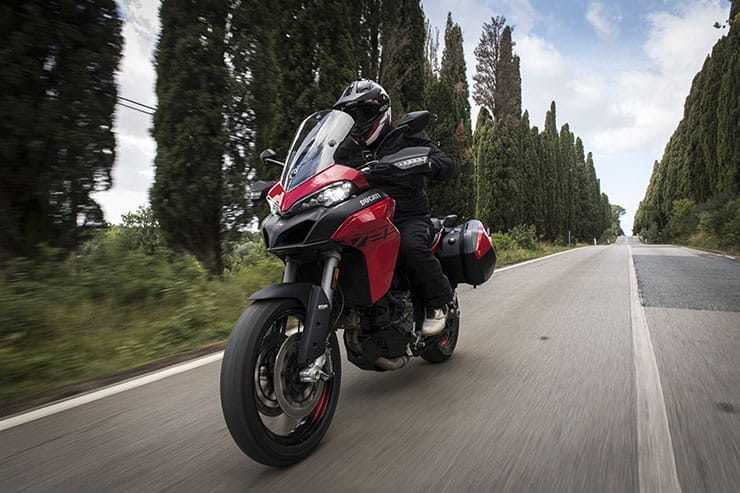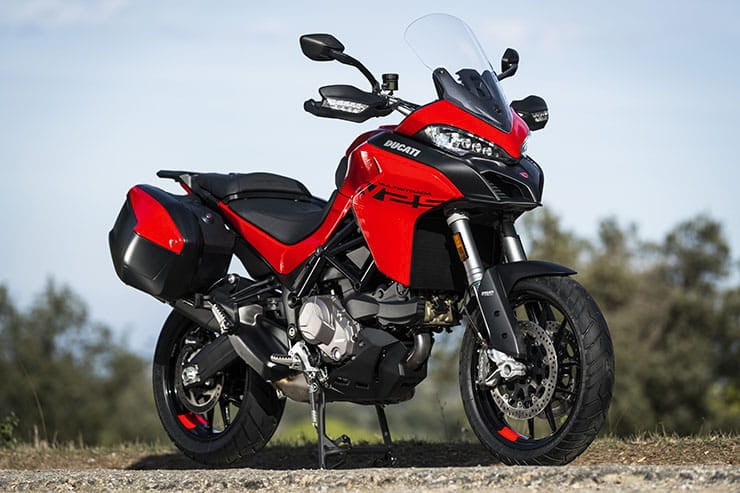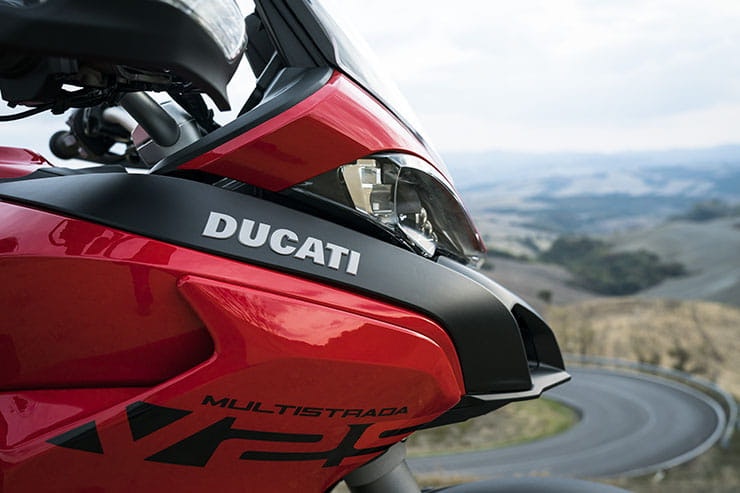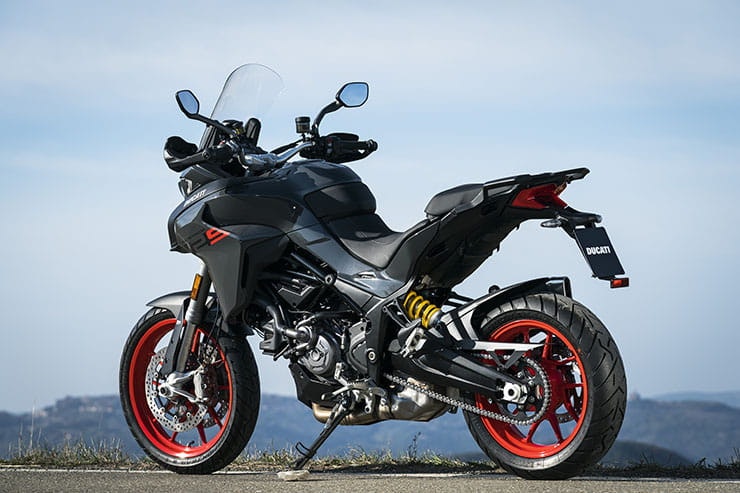Ducati Multistrada V2 (2022) - Review
BikeSocial Road Tester
22.12.2021
Launched in 2017 as the Multistrada 950, revamped for 2020 with the addition of an up-spec S model and, and now 2022 rolls around with Ducati announcing third iteration of Multistrada 950, but with a different name: the V2, V2 S and V2 S Travel.
But this isn’t a major Multistrada overhaul. In fact, most of the V2 is exactly the same as the preceding 2021 Multistrada 950. Most of the engine, frame, swingarm, suspension, clocks and front end of the bodywork are the same. The differences are limited to lower seat height and less seat width, lower overall weight, swapping a few parts with some borrowed from the Multistrada V4, a few refinements to clutch and transmission, and the introduction of an A2-licence 47bhp model.
So why have Ducati gone to the trouble of laying on a lavish two-day launch in Tuscany for a bike that’s so close to last year’s machine? Because, say Ducati, what the Multistrada V2 represents for the factory – the broadening of Ducati’s appeal to a wider (and, er, less tall) range of riders – is as important as what the bike actually is. And it’s already very good indeed.
BikeSocial gets the story, and rides the new Multistrada V2.
Engine – smooth, easy to control, plenty of go; a Ducati V-twin anyone can dance with
Handling – 19in front is light, with plenty of feel and precision
The little things – adjustable screen, backlit switches, easy menus, big mirrors
Quickshifter – personal taste, but on the V2 S it’s too aggressive for my clumsy plates
830mm seat – how low can you go? Too low for big ’uns so make the right choice when you buy the bike
2022 Ducati Multistrada V2 review - what's new other then the name?
Launched in 2017 as the Multistrada 950, revamped for 2020 with the addition of an up-spec S model and, and now 2022 rolls around with Ducati announcing third iteration of Multistrada 950, but with a different name: the V2, V2 S and V2 S Travel.
Ducati Multistrada V2 (2022) Price and Availability
The Multistrada V2 is already on sale in the UK and comes in two colours: Ducati Red and glossy Street Grey.
The V2 has three levels of trim, which mirror the spec levels of last year’s MS 950:
The base V2, which costs £12,495
The up-spec V2 S, which costs £14,495 and adds semi-active suspension, an up/down quickshifter, backlit switches, LED lights with cornering lights and a TFT dash instead of LCD
The V2 S Travel for £15,525 which adds panniers, centre stand and heated grips
Accessory packs include the Urban Pack (topbox, USB cable and lockable tankbag) for an extra £600 and an Enduro Pack (crash bars, rad and oil cooler covers, bash plate and fog lights) for £1272. Wire wheels aren’t included in the Enduro pack but are available for £1404.
The V2, V2 S and V2 S Travel also come in a 47bhp version for use on an A2 licence. It costs the same as the full-power bikes – but only in the UK; across the rest of Europe, it’s €1000 cheaper, but Ducati say import duty post-Brexit means UK A2 riders wanting a Multistrada V2 have to cough up full price. Please address grievances and/or arguments elsewhere; we’re just reporting what they said. Seriously, I only mention it because I asked, so please don’t come at me.
Ducati V2, V2 S and V2 S Travel PCP details are not yet available on the TriOptions website.
2022 Ducati Multistrada V2 power and torque
As the engine is largely unchanged, at least in terms of performance, the claimed power and torque figures are the same as the 2021 Multistrada 950:
Peak power is 113bhp @ 9000rpm
Peak torque is 69 lb/ft @ 6750rpm
Engine feel and performance
The V2’s 937cc 90° V-twin is almost identical to the 2021 MS 950 motor – for 2022 it gets new, lighter conrods and eight-disc clutch (previously nine discs). Combined, they save 1.68kg – in total, the engine is 2kg lighter (the rest comes from a new clutch cover and a redesigned gear drum and selector forks).
And… that’s yer lot. This is the same engine used in the SuperSport, Hypermotard and new Monster (but in slightly different states of tune to suit intended riding use) – and it’s a very good motor; thoroughly refined, easy to use, powerful, tractable, civilized and yet bloody quick when you need it to be. It hasn’t got the heavyweight shove of the bigger-capacity adventure bikes – Ducati’s own MS V4 or the old MS 1260, KTM’s 1290 SA, BMW’s R 1250 GS or, doubtless, the forthcoming Tiger 1200 – so if you get your kicks surfing massive waves of torque and reigning-in hellish-fast top ends, then the MS V2 isn’t your bike. But if you appreciate a less theatrical engine; in performance terms it’s more like a good TV box-set than a big-budget Hollywood event; then it’s everything you could want. Especially when it comes to simple, everyday ease-of-use.
The launch conditions showed this up perfectly. Day one was utterly sodden, with a simultaneous combination of torrential rain and thick mountain cloud – basically, fog – the like of which I’ve never ridden in before. It was like riding head-on into a firehose with a blanket over your head. It rained so hard the V2 refused to go out the next morning until it was treated to a blow-dry. But day two was much more like it – white cloud, a bit of sunshine, damp-but-drying roads and gusty sidewinds let the Ducati stretch its legs a bit more freely.
In the rain the V2 S is surefooted and precise thanks, in no small part, to a high degree of manageability Ducati have engineered into the drivetrain’s throttle connection and smoothness. The link between right hand and rear Pirelli Scorpion Trail II is direct and precise, but isn’t harsh or snatchy – helped by choosing the appropriate rider mode for the weather conditions: Urban softens the semi-active suspension a bit too much, but offers a high level of traction control and softer throttle response; I preferred the extra precision of Touring mode in the wet, but using Sport mode in rain is asking for it – as a launch colleague from Austria found out the hard way! You can, of course, dial in your preferred settings with a custom mode.
Ducati introduced Euro 5 regs on the Multistrada 950 last year (but didn’t make any fuss about it, so I assumed the V2 was the first Euro 5 Multi 950; wrong!). Euro 5 is assumed to be the devil incarnate when it comes to throttle control, because if Euro 4 made throttles really snatchy, Euro 5 must be worse, right? Ain’t necessarily so.
In 2016, the introduction of Euro 4 coincided with the widespread introduction of fly-by-wire throttles, and many manufacturers were in the foothills of developing and refining effective, pain-free engine management strategies. Modern motorcycle engine management is a mind-bogglingly complex area requiring highly specialist experience and knowledge – the demands of riding a bike need specific engineering expertise that can’t be cross-transferred from automotive R&D (which is generally ahead of bikes). That’s why smaller manufacturers (such as MV Agusta) face an uphill struggle making their bikes as ‘ride-able’ as bigger factories; they don’t have the resources to develop that expertise and knowledge base.
Anyway, as a result, a lot of Euro 4 bikes came to market with comparatively lean, harsh fuelling, and snatchy throttle control – Suzuki’s GSX-S1000 and Yamaha’s Tracer 900 spring to mind. Come Euro 5 few years later, manufacturers are much better placed to incorporate the new regs into substantially refined engine management. Thus bikes like Suzuki’s GSX-S1000 GT and Yamaha’s Tracer 9 GT – using, essentially, the same engines – now have intuitive, manageable, un-snatchy throttles. It’s easy to pick up a trailing throttle mid-corner and dial in exactly the amount of drive you want.
The Multistrada 950 was never an awkward bike to ride anyway, but the V2 is positively benign in the wet – it’s got no rough edges to its control surfaces; it’s easy to use sparingly and carefully, tip-toeing through puddles without a care. Point being Euro 5 isn’t the reason it’s so good, but it hasn’t made it worse.
While we’re on about the MS V2’s engine, it’s worth noting the A2 licence 47bhp version –Ducati won’t say how is restricted but we can assume the days of blocking off exhaust and intake with crude baffles are long gone (are they?) – can ‘only’ be de-restricted to 94bhp, not the full-fat 113bhp; this is how Ducati get round the legislation limiting A2 bikes to a 94bhp ‘host’ engine. Not sure that’s entirely within the spirit of the rules, but it sounds good to me.
Gearbox and exhaust
Transmission and exhaust are as per the 2021 MS 950, bar a redesigned gear drum and selector forks which save 110g and give smoother, more precise gear changes – although again, it wasn’t crude in the first place. Ducati have also refined the quickshifter strategy for more consistent shifting (it’s standard on the V2 S and an optional extra on the base V2). I remember, on the launch of the previous 950 S in 2019, complaining (whinging, really) to a Ducati test rider, saying I found Ducati’s quickshifters hardest to manage – they seemed too abrupt and, because I have a lazy left foot, I often ended up ‘double-tapping’ the lever and getting a sudden cut in power, lurching me forward into the screen. I was, I noted, about the only person I knew who had the problem. “No, that happens to me too!” said the test rider, which made me feel better, although he might’ve been taking pity on me. It’s hard to tell sincerity from condescension on press junkets, but I prefer to play it safe and assume the latter.
Anyway, enter the V2 S – and the quickshifter is much better. I only had a couple of dreaded double-taps (which is still two more than I’ve had in 6000 miles on Yamaha’s Tracer 9 GT, currently the high-water mark of quickshifter excellence). But normally I’d be pre-wincing during the change from first to second under full power; no more.
Fuel economy
The V2’s tank is 20 litres deep and the bike’s onboard trip was claiming an average slurpage of 5.4 litres per 100km over the duration of the launch ride – which <Googles the maths> is 43.6mpg, giving a theoretical range of 191 miles. So the reserve will illuminate the dash at around 150 miles.
In terms of fuel economy (let alone riding impressions in general), launches can be deeply misrepresentative of normal, everyday use (unless you treat the road like a race track) – they’re often a worst-case scenario deal. But this launch, thanks to the moistness of the first day and moderate pace for the rest of the ride, felt a pretty faithful to the kind of fuel consumption in normal use.
Handling: frame, suspension and weight
At the risk of sounding like a stuck record stuck record stuck record, the V2’s chassis is as per the 950 – same steel trellis frame, same ally double sided swingarm, same fully adjustable 43mm forks and shock on the V2 and semi-active Skyhook system on the V2 S (which was the only bike available to ride on the launch). Weight is down by 5kg to a kerb figure of 225kg thanks to the aforementioned 2kg saved in the motor, plus another few kilos dropped by swapping over to some Multistrada V4 parts – namely the wheels (which saves 1.7kg) and brake disc carriers (500g) which, seeing as they’re rotating parts and unsprung mass, makes it the most valuable weight of all to save.
Back in the days when all Multistradas were V-twins, some people (including me) held the opinion the 950, with its 19in front wheel, was the sweeter-steering Multistrada compared to the 17in front 1260 (although that’s probably also down to the narrower 170 rear, too). It suited the bike’s riding position and chassis dynamic better, giving the 950 more agility, precision and lighter steering. And that’s how the V2 still feels – I can’t detect the significance of the reduction in weight, but the MS 950 wasn’t exactly steamboat fatty anyway, and still isn’t. Maybe if we rode the two back-to-back the new bike would feel lighter still… but, as it is, the V2 S flicks and giggles its way around the Tuscan hillsides with a joyful panache, revelling in the familiarity of its surroundings. The Skyhook semi-active suspension is effective, in the sense changing riding modes introduces a different character to the springs: Sport is definitely the sportiest setting, holding the bike’s poise better when hard on the brakes or on the gas, but not actually reducing ride quality noticeably – and at the other end, Urban mode makes the V2 sit down a bit at the back, drags the steering, but mostly feels like riding a jelly when it hits a bump. It feels as if adjusting the semi-active doesn’t so much alter the damping rate as just give you more or less of it, a bit like using a screwdriver. But either way, in Sport or Touring mode the V2 is controlled, balanced and evenly tempered on its wheels. It even runs over crazy Tuscan pheasants without a blip, may the Lord bless its feathery soul.
Wheels, tyres and brakes
The V2 comes on Pirelli’s Scorpion Trail IIs, which look great and are very happy in the wet. They’re not a specialist rain tyre as such – I’ve ridden these exact same roads in Tuscany (visiting San Galgano and the avenue of Cypress trees – the Viale dei Cipressi – at Bolgheri) this year on Bridgestone’s new T32 – funnily enough, it was chucking it down then, too (“Come to sunny Tuscany!”, they said). I’ve never seen a rear tyre lift water off the road like the T32 does – if you follow a bike with one on, it’s like riding in a shower. The Pirelli’s not in the Bridgestone’s league when it comes to wet grip, but in the dry it’s got a neutral, stable character that suits the bike without flattering it.
The V2’s four-pot Brembo calipers and 320mm discs are, yes, the same as last year’s (excluding the aluminium disc carriers) and, as they were then, are as effective at stopping the bike as the cornering ABS allows – which is pretty sharpish. No complaints.
Equipment, styling, ergonomics and comfort
The base V2 comes with a 6-axis IMU and full kitchen sink of engine management, traction control and rider mode options, plus cornering ABS. The V2 S add a TFT screen, semi-active, quickshifter, cruise, backlit switches and LED lights and cornering lights, and the V2 S Travel adds panniers, heated grips and a centre stand. All bikes have a 12v socket in the dash and a USB port where it’s less use, under the pillion seat. None of them have adaptive cruise as per the MS V4, or that bike’s rear blind spot detection.
The V2’s screen is as before, one-hand adjustable and not prone to wind buffeting or excessive noise. The V2 S Travel’s panniers are 26 and 30 litres – the left box holds a full face lid, but during the launch I used Ducati’s pannier inner bags to hold my smalls and video equipment, and they swallowed it all. No mean feat.
And now, finally, congrats on getting this far, we get to the bit the 2022 MS V2 is all actually all about: ergonomics. Ride a Ducati 10 years ago and you’d get big, thumping V-twin vibration, a drivetrain with the flexibility of a jack-hammer and suspension that would prop up a bridge. Ducati were a speciality flavour; they weren’t for everyone. When you rode a Ducati, it was rarely a benign or friendly kind of bike – they were aloof, different, hard work and hard-assed; you had to adapt yourself to ride one. And you either liked their recalcitrance and got on with it or, like me, you regarded them warily and never warmed to them.
If that was your experience then, trust me, that’s not where Ducati are now. Yes, the MS V2 is a big V-twin and yes, it makes shuddering V-twin vibes when you open it up. But the chain doesn’t try and jump off the sprockets and the motor doesn’t sound like it’s about to cough up one of its lungs. Similarly, the suspension behaves conventionally – it’s not stiff or bad tempered; the V2 is smooth and tactile, all touchy-feely rather than aggressive and gnarly. Which is why, for riders like me, modern Ducatis are a joyful revelation every time I ride one. Heck, the MS V4 is one of my faves of all time.
And that civility and ease-of-use has been a deliberate, intentional, stated factory design target; Ducati say its user-friendly philosophy is so deeply rooted in the company it’s even mirrored in the performance of their MotoGP Desmosedici – 15 years ago, only Casey Stoner could wrestle the thing onto the podium; this season, five different riders have put a Ducati in parc fermé. It’s better for everyone. Die-hard Ducatisti might not like their elite domain being opened to all-comers, but they can still go out and get their kidneys pummelled by a 1979 900SS should they so wish.
And so, with one eye also on the emerging markets in Asia (where, Ducati say by 2026, sales of Ducatis will outstrip the UK – which is a pretty big market for them), the 2022 MS V2 gets a reduction in seat height by 10mm from 840mm to 830mm. Big deal? There’s more – the seat and bodywork beneath it are also slimmed down too. So now not only is the seat lower, it’s narrower, giving the rider a much better chance of getting both feet on the floor.
With 830mm as the standard seat option, the low seat is now 810mm and the high seat is 850mm – and, as before, a suspension lowering kit is available as a factory option which takes seat height down to 790mm, or less than a Triumph Speed Twin and around the same as a Suzuki SV650. Ducati have also fitted pegs from the MS V4, which give 10mm more seat-peg legroom. The bars are the same width, with a small range of adjustment depending on where you like them placed in the clamps.
It’s easy to make light of or disregard the reduction in seat height as unimportant, especially if you’re a six foot plus beefy bike journo (not many meet the beefy criteria, to be fair). But seat height is a serious issue for many, many riders – limiting bike choices not because they can’t be ridden, but because it makes them too awkward to use comfortably. And it’s a problem almost always ignored in road test and launch reports.
As a six-footer, it’s hard for me to comment on the effectiveness of the new seat height for folk less than 6ft, but I can say the high option 850mm seat is the right choice for me and I’d even prefer something a bit higher and maybe wider than that. The standard 830mm seat is too low for me (which presumably means it’ll be more right for people less than 6ft) and puts a bit too much pressure on the old biffing skin – the perineum; after a few hundred miles I was shifting around a bit, and sometimes standing up for a stretch.
And speaking of which, I’ve talked quite enough balls for now.
Ducati Multistrada V2, V2 S and V2 S Travel (2022): VERDICT
Ducati say the MS V2 is their “…gateway to Ducati’s touring universe”. They’ve made it lower, slimmer, easier for less lanky gits to ride – and at the same time trimmed some weight and introduced an A2 model. The fundamental bike is the same as the 950 has been for a few years: not a sleeved-down, junior version of the big Multi, but a fully-featured premium machine in its own right with a lighter, less imposing presence than big adventure bikes. Which isn’t bad for an entry-level Ducati.
Ducati Multistrada V2 S (2022) Technical Specification
What is MCIA Secured?
MCIA Secured gives bike buyers the chance to see just how much work a manufacturer has put into making their new investment as resistant to theft as possible.
As we all know, the more security you use, the less chance there is of your bike being stolen. In fact, based on research by Bennetts, using a disc lock makes your machine three times less likely to be stolen, while heavy duty kit can make it less likely to be stolen than a car. For reviews of the best security products, click here.
MCIA Secured gives motorcycles a rating out of five stars, based on the following being fitted to a new bike as standard:
A steering lock that meets the UNECE 62 standard
An ignition immobiliser system
A vehicle marking system
An alarm system
A vehicle tracking system with subscription
The higher the star rating, the better the security, so always ask your dealer what rating your bike has, and compare it to other machines on your shortlist.



